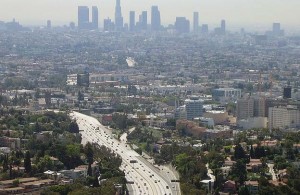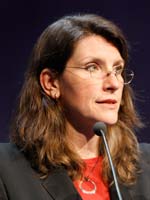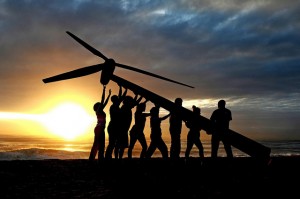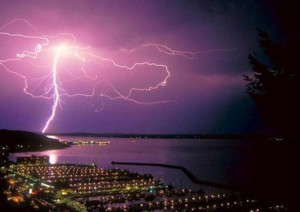More Midwestern Extreme Storms
The new NRDC-RMCO report adds several years of data to previous reports tracking the issue of Midwestern storms. Key findings include:
Since 1961, the Midwest has had an increasing number of large storms. The largest of storms, those of three inches or more of precipitation in a single day, increased the most, with their annual frequency having increased by 103 percent over the roughly half century period through 2011. Read the full report: Climate Study- Extreme Rain Storms in Midwest Have Doubled in Last 50 Years, Often Leading to Worsened Flooding
Climate Change Unbelievers
 By Bill McKibben – The Heartland Institute—a main climate-denial front group—chose an interesting day to put up billboards around Chicago in advance of their next meeting.
By Bill McKibben – The Heartland Institute—a main climate-denial front group—chose an interesting day to put up billboards around Chicago in advance of their next meeting.
This morning—even as the first actions of Connect the Dots day were taking place in the Pacific—they unveiled the signs, which have big pictures of Ted Kacynzki and Charles Manson, two convicted mass murderers, with the question: “I Still Believe in Global Warming, Do You?”
The message couldn’t be clearer—anyone who’s worried about climate change is abnormal, weird, sick, twisted.
So our message back need to be just as clear and firm: in fact, its normal people around the world who are engaged in the fight against climate change. Some are famous—the pope, the Dalai Lama, the patriarch of the Orthodox Church—but most of us are just ordinary citizens. And we’re worried about climate change because we can see what’s going on around us with our own eyes.
The industry is terrified to talk about extreme weather that has led a big majority of Americans to back action on climate change, and they are terrified of the beautiful movement that is growing all across this country. That’s why groups like the Heartland Institute are so desperate—that’s why they’re insisting that it’s serial killers and not scientists and citizens who care about climate change.
We have no idea why companies like Microsoft continue to support the Heartland Institute, and you can sign a petition here letting them know it’s a bad idea to encourage this kind of hatred. But the most important thing you can do is turn out everyone you know for tomorrow’s day of action.
Citizens like us taking action in our communities may be the only way that we can fight back against an industry with so much money and ill-will at their disposal. This weekend we can show the real face of climate change – both the impacts that are already roiling our world, but also the people who are taking action to stop it.
They’re getting desperate, which is a good sign.
American Lung Association Releases 2012 Report on Air Quality
13th annual State of the Air 2012 report shows continued progress, challenges
 The American Lung Association released the State of the Air 2012 today, an annual report on air quality which lists both the cleanest and most polluted areas in the country. This year’s report shows that although California still has some of the worst air in the nation, continuous progress in reducing ozone and particulate pollution has resulted in the state’s air quality at its cleanest since the Lung Association’s annual report began 13 years ago. The findings reinforce the effectiveness of California’s progressive clean air laws and investments and the importance of the Clean Air Act.
The American Lung Association released the State of the Air 2012 today, an annual report on air quality which lists both the cleanest and most polluted areas in the country. This year’s report shows that although California still has some of the worst air in the nation, continuous progress in reducing ozone and particulate pollution has resulted in the state’s air quality at its cleanest since the Lung Association’s annual report began 13 years ago. The findings reinforce the effectiveness of California’s progressive clean air laws and investments and the importance of the Clean Air Act.
“This report shows that air pollution remains a serious health threat to too many Californians,” said Jane Warner, President and CEO of the American Lung Association in California. “State of the Air 2012 shows that we’re making real and steady progress in the fight for clean air, but unhealthy levels of air pollution still exist, putting the health of millions Californians at risk. Much still needs to be done, and now is not the time to stop progress.”
More than 90 percent of Californians still live in counties plagued with unhealthy air, particularly in the Central Valley, Los Angeles, Inland Empire, Sacramento, and San Diego. That means more people are at risk for asthma attacks, heart attacks, and premature death. California cities once again dominate lists for the top ten most polluted areas in the nation for ozone (smog) and short-term and annual particle pollution. Specifically, of the top ten cities with the worst air pollution, California ranks as follows: Full article: American Lung Association Releases 2012 Report on Air Quality
The Most Extreme Weather on Earth
ClimateWorks Foundation Appoints Julie Blunden New CEO
Julie Blunden, renewable energy industry veteran, to lead global climate and energy policy grantmaker
 The ClimateWorks Foundation board of directors announced today that it has appointed Julie Blunden, a 25-year veteran of the energy industry, as the Foundation’s new Chief Executive Officer, effective May 21, 2012. Ms. Blunden is a widely recognized energy policy expert with extensive applied experience in both the industrial and non-profit sectors.
The ClimateWorks Foundation board of directors announced today that it has appointed Julie Blunden, a 25-year veteran of the energy industry, as the Foundation’s new Chief Executive Officer, effective May 21, 2012. Ms. Blunden is a widely recognized energy policy expert with extensive applied experience in both the industrial and non-profit sectors.
“Design to Win: Philanthropy’s Role in the Fight Against Global Warming.”
“Julie has spent her entire career focused on the nexus of energy technology, policy, and markets,” said Foundation Chairman and former EPA administrator William Reilly. “As ClimateWorks enters the next phase of its continuing evolution, we’re excited to have Julie’s strong leadership and deep expertise to help drive us toward a low-carbon future.”Ms. Blunden will join ClimateWorks after completing her service as executive vice president of the SunPower Corp., which she helped grow into one of the world’s leading solar power companies. Previously, she co-founded Green Mountain Energy Company, an early provider of direct-to-consumer renewable energy products and programs. As a development manager for AES Corp., Ms. Blunden oversaw the development of power generation projects around the world. She currently sits on the boards of several non-profits that are active in clean energy policy advocacy.
Ms. Blunden’s appointment came after an extensive, international search led by a subcommittee of the ClimateWorks Foundation board of directors, chaired by Chad Holliday, chairman of Bank of America, and including board chairman Mr. Reilly and Bertrand Collomb, Honorary Chairman of Lafarge. She succeeds Hal Harvey, who left ClimateWorks in December 2011.
“My career has provided me with great insight into the potential pace of technological change in the energy industry,” said Ms. Blunden. “However, technology is not the limitation to lowering global carbon emissions, rather it is market design, public policy and business engagement. I am honored to join ClimateWorks and its network of partners, which have already made major contributions to reducing carbon emissions around the world. I look forward to extending ClimateWorks’ success, both with our current partners and new allies who can help expand our reach.”
The ClimateWorks Foundation’s major donors expressed their strong support for Ms. Blunden and the Foundation as she makes the transition to the role of CEO.
“ClimateWorks has always taken a rigorous, metrics-based approach to solving the problem of climate change, and Julie’s private sector experience and discipline will be a great complement to a very focused institution,” said Paul Brest, President of the William and Flora Hewlett Foundation. “We look forward to working with Julie for many years to come.”
“Julie truly believes in the mission and values that guide ClimateWorks’ philanthropic efforts,” said Carol Larson, President of the David and Lucile Packard Foundation. “Her passion for this cause, and deep subject matter expertise, make her a great choice to lead ClimateWorks.” “The ClimateWorks Foundation’s unique approach to reducing carbon emissions through policy and advocacy is invaluable to the field,” said Kate Wolford, president of the McKnight Foundation. “We are pleased to support ClimateWorks’ efforts during this important leadership transition.”
Michael Mann – A Look Into Our Climate: Past To Present To Future
Darwin Comes to Durban:Overcoming “Survival of the Fittest” Mentality at UN Climate Talks
 by Kelly Rigg
by Kelly Rigg
This recent Bloomberg headline sums up just about everything that’s wrong with the UN climate negotiations, which get underway in Durban, South Africa tomorrow: “Saudis Seek to Ensure Climate Talks Won’t Hurt OPEC Oil Income.”
Addressing climate change by definition requires countries to look beyond their national self interests, but in practice, a Darwinian “survival of the fittest” mentality has taken hold. And by “fittest” I mean major emitters from both developed and developing countries that apparently have all but stitched up an agreement amongst themselves to delay new binding international climate action until 2020.
If they succeed, this would be a scandalous abrogation of duty and a breach of the public trust. “Shocking and irresponsible” is how Grenada’s Minister for the
Environment described it. In the most optimistic scenario, existing pledges amount to roughly half of what we need to stave off catastrophic climate change — now is the time to ratchet up ambition, not dial it down. Read the full article
What is a Carbon Fee and Dividend ?
By Todd J. Smith, Citizens Climate Lobby volunteer
 Why is this legislation necessary?
Why is this legislation necessary?
This legislation will put us on the path of a sustainable climate by reducing our greenhouse gas emissions and transitioning us to a clean energy economy. Since the beginning of the industrial revolution we have increased the level of greenhouse gases, especially carbon dioxide (CO2), in our atmosphere. Scientists warn that this is having a drastic affect on our climate. Changes that would normally take thousands of years are happening in decades. In effect, we have covered the earth with a large blanket of greenhouse gases and the earth is warming up. The oceans are absorbing this increased carbon dioxide in the atmosphere, making them more acidic. Eventually, this acidity will affect the oceans’ ability to support life.
What is a carbon fee?
It is a fee based on the amount of carbon in a fossil fuel. Fossil fuels such as oil, gas and coal contain carbon. When burned they release the potent green house gas, carbon dioxide (CO2), into the atmosphere. The fee is based on the tons of carbon dioxide the fuel would generate, and it would be collected at the point of entry — well, mine or port. The fee would start out low — $15 per ton — and gradually increase $10-$15 each year. The amount would be determined by Congress.
How much will the carbon fee effect energy prices?
The best example would be gasoline. A $1 per ton increase in the carbon fee would equal about 1 penny on the price of gas. So if the carbon fee started at $15/ton, gasoline would go up by 15 cents per gallon the first year and 10-15 cents each year afterward.
What is the dividend?
A dividend is defined as a quantity of revenue to be divided. In this case, 100 percent of the total carbon fees collected are divided up and given back to all citizens equally. This dividend helps citizens pay the increased costs associated with the carbon fee while our nation transitions to a clean energy economy.
How does Carbon Fee and Dividend legislation work?
Carbon Fee and Dividend legislation puts a fee on the amount of carbon dioxide in fossil fuels. This fee is assessed at the source of the fuel: at the mine, well, or port of entry. The fee starts out low and increases annually in a predictable manner until green energy is competitive with fossil fuel. The fee is collected and 100 percent reimbursed to all citizens, shielding them from the financial impact of the transition to a clean energy economy. Because the fee (and the price of fossil fuel) goes up predictably over time, it sends a clear price signal to begin using fossil fuels more efficiently or replace them with green energy. Investment flows to green technologies and the rising cost of fossil fuels increases the demand for these products, making them even less expensive as they reach mass production. This clear easy to understand price signal (increasing fossil fuel costs and decreasing green technology costs) drive the transition to a green economy. This transition will reduce greenhouse gases stabilizing, our climate and the health of our oceans. Read Full Article: Carbon Fee and Dividend
Bill McKibben’s Keystone XL Speech at Occupy Wall Street
Text
Today in the New York Times there was a story that made it completely clear why we have to be here. They uncovered the fact that the company building that tar sands pipeline was allowed to choose another company to conduct the environmental impact statement, and the company that they chose was a company was a company that did lots and lots of work for them. So, in other words, the whole thing was rigged top to bottom and that’s why the environmental impact statement said that this pipeline would cause no trouble, unlike the scientists who said if we build this pipeline it’s “game over” for the climate. We can’t let this pipeline get built.
On November 6, one year before the election, we’re going to be in DC with a huge circle of people around the White House and they’re going to be carrying signs with quotations from Barack Obama from the 2008 campaign. He said, “It’s time to end the tyranny of oil.” He said, “I will have the most transparent government in history.” We have to go to DC to find out where they have locked that guy up. We have to free Obama, because there is some sort of stunt double there now. So on November 6, I hope we can move, just for a day, Occupy Wall Street down to the White House and get them in the fight against corporate power.
The reason that it’s so great that we’re occupying Wall Street is because Wall Street has been occupying the atmosphere. That’s why we can never do anything about global warming. Exxon gets in the way. Goldman Sachs gets in the way. The whole fossil fuel industry gets in the way. The sky does not belong to Exxon. They cannot keep using it as a sewer into which to dump their carbon. If they do, we’ve got no future and nobody else on this planet has a future.
I spend a lot of time in countries around the world organizing demonstrations and rallies in solidarity. In the last three years at 350.org, we’ve had 15,000 rallies in every country except North Korea. Everywhere around the world, poor people and black people and brown people and Asian people and young people are standing up. Most of those places, don’t produce that much carbon. They need us to act with them and for them, because the problem is 20 blocks south of here. That’s where the Empire lives and we’ve got to figure out how to tame it and make it work for this planet or not work at all.
Thank you guys very much.
Warming climate could give exotic grasses edge over natives
 BERKELEY – California’s native grasses, already under pressure from invasive exotic grasses, are likely to be pushed aside even more as the climate warms, according to a new analysis from the University of California, Berkeley.
BERKELEY – California’s native grasses, already under pressure from invasive exotic grasses, are likely to be pushed aside even more as the climate warms, according to a new analysis from the University of California, Berkeley.
In the study, which has been accepted for publication in the journal Global Change Biology and is now available online, UC Berkeley biologists catalogued the ranges of all 258 native grasses and 177 exotic grasses in the state and estimated how climate change – in particular, increased temperature and decreased rainfall – would change them.
They concluded that many of the traits that now make exotic grasses more successful than many natives also would allow them to adapt better to increased temperature and likely expand their ranges.
“When we looked at current patterns, we found that warmer temperatures favor certain traits, and these are the traits possessed by exotic species,” said coauthor Emily Dangremond, a graduate student in the UC Berkeley Department of Integrative Biology. “This led us to predict that, if the mean temperature increases in all zones in California, there is an increased likelihood of finding exotic species, and an increase in the proportion of species in a zone that are exotic.” Read the full article: Warming climate could give exotic grasses edge over natives
More on Climate Change

